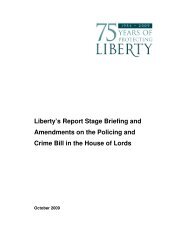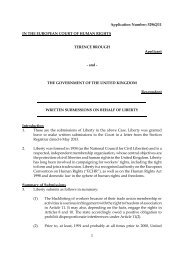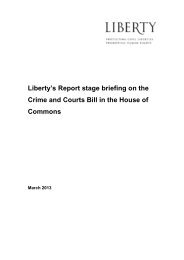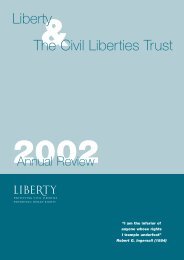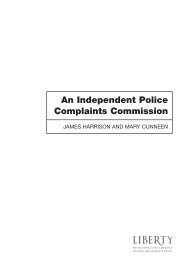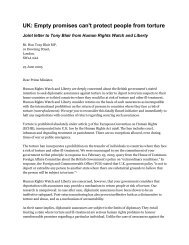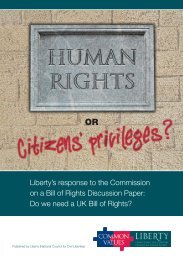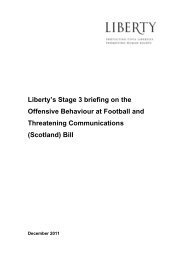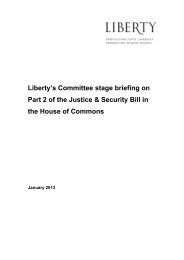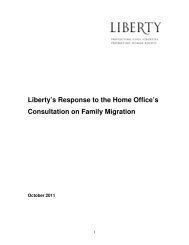Overlooked - Liberty
Overlooked - Liberty
Overlooked - Liberty
Create successful ePaper yourself
Turn your PDF publications into a flip-book with our unique Google optimized e-Paper software.
<strong>Overlooked</strong>: Surveillance and personal privacy in modern Britain 71<br />
• Private companies, for an annual fee, retain the samples from which the data contained in the<br />
NDNAD are derived. These samples contain vast amounts of genetic information, including<br />
health-related information. There is nothing to prevent these companies using samples to<br />
develop mini databases of DNA records.<br />
• The Database is also connected to the Police National Computer. This could exacerbate privacy<br />
implications because connections can be drawn between sets of personal data. Similarly PNC<br />
records are now retained indefinitely as a result of the link to the Database, whereas before they<br />
would have been weeded out after a short period of time. Furthermore, information contained on<br />
the PNC is visible to a wider range of non-policing bodies. In short, the effect of the NDNAD is<br />
not limited to that database but has a wider impact on other police records.<br />
• It is possible in the future that connections will be made between the National Identity Register<br />
and the Database. A recent Home Office document on the NIR explains that “it will have links<br />
with other Government systems to share identity data” and even suggests that the biometric<br />
data element of the NIR will, in fact, be stored on “existing biometric systems” 151 . If the<br />
bioinformation in the NDNAD were to form part of the NIR, this would represent a significant<br />
extension of the stated law-enforcement purpose of the Database. Linking the NIR with other<br />
biometric databases is clearly already part of Government thinking. The former Prime Minister<br />
Tony Blair made this clear when sending an email to the 27, 000 signatories to an anti ID card<br />
petition on the Number 10 website. In it he said “I believe that the National Identity Register will<br />
help police bring those guilty of serious crimes to justice. They will be able, for example, to<br />
compare the fingerprints found at the scene of some 900,000 unsolved crimes against the<br />
information held on the register.”<br />
Voluntary DNA samples<br />
DNA is occasionally provided voluntarily. This might occur if a victim of crime provides their DNA for<br />
elimination purposes during the course of a criminal investigation. Samples might also be volunteered<br />
to the police in response to requests for people in a geographical location to rule themselves out of<br />
a crime investigation. At present over 12,000 volunteer samples are contained in the Database. The<br />
samples that are retained may be used in the future in the same way as samples taken from convicted<br />
criminals. A person who has volunteered for their DNA to be put in the Database has no right to have<br />
this bioinformation removed. This can prove to be problematic both in principle and practice. If a<br />
person’s consent is needed to take a DNA sample then it might be expected that they are able<br />
withdraw that consent and consequently to require their sample to be removed. This might raise<br />
practical concerns if people are aware that any bioinformation they voluntarily provide could be<br />
retained for future use, they might be less inclined to co-operate. In the long run it might be that a<br />
failure automatically to destroy any sample provided to the police might hinder investigations.<br />
Uses of DNA samples<br />
Some of the uses of DNA potentially raise ethical issues. The police are currently in favour of the<br />
recovery of physical information on an individual (from crime scene DNA where there is no match to<br />
151<br />
Strategic Action Plan for the National Identity Scheme: Safeguarding your Identity, Home Office,<br />
December 2006, pages 7 and 11.



